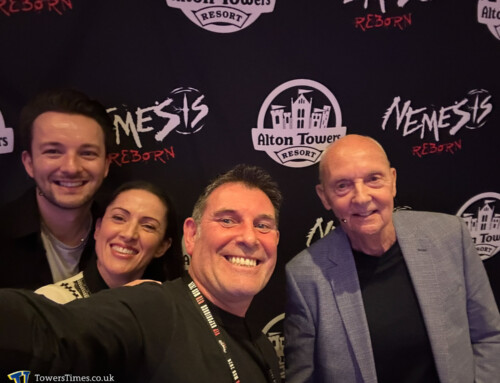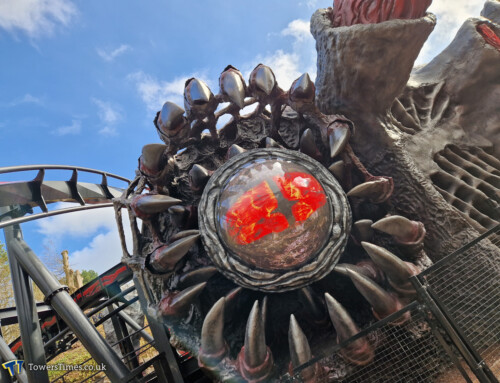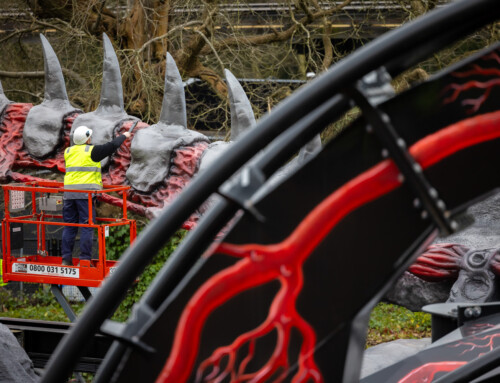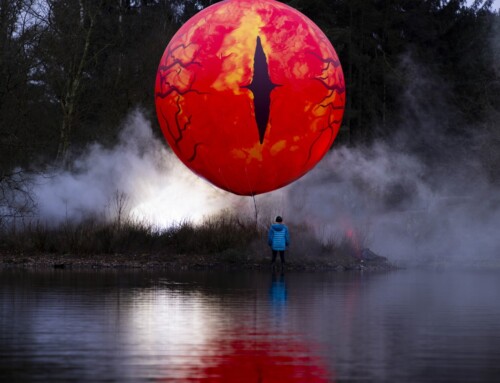There’s no doubt about it, the transformation of Nemesis into Nemesis Reborn at Alton Towers Resort has been fascinating to watch. Whether you have occasionally dipped in and out of the progress, or like me, take an interest in the technical aspects and followed the construction closely throughout the whole project timeline, the complete reimagining of such an iconic ride over the last eighteen months has captivated everyone. In this article, we’ll take a look back at what the original ride looked like, and compare it to the current iteration that has been future-proofed for generations to come.
The original Nemesis came to the end of its working life, and I was very pleased that Alton Towers and Merlin Entertainments recognised the importance of maintaining such a world class attraction. It was always going to be interesting to see how that was done. Is Nemesis going to be renamed? Will the colour scheme change? Are the trains going to change to those with vest restraints? Will the coaster maintain its iconic roar? All valid questions when the initial details emerged in January 2022, and ones that were answered as the project progressed.
Alton Towers never had to apply for planning permission – instead an application for a Certificate of Lawfulness was made, which in a nutshell is a formal way to be certain that a proposal does not require planning permission. As a recap, let’s remind ourselves what work was originally proposed in the application:
- Replacement of coaster track from the crest of the lift hill, to the start of the brake run.
- Replacement of 89 of the 117 supports in these areas.
- Removal of 636 bolts which will be replaced and re-grouted.
- Localised maintenance undertaken to the theming and buildings as required.
- The tunnel section below the maintenance building will be retained as existing, and the coaster track which runs through the tunnel replaced alongside the structural beam.
- Footers will be strengthened in limited locations, and an additional foundation installed for a support on the downwards helix, which has received modifications in the past.
- The replacement track and supports will follow the existing layout and design, and will have the same appearance externally.
- The coaster track will be sand filled, which will reduce noise levels to the benefit of the site and local area.
And now let’s take a look at what was stated to be unaffected by the proposed work:
- The 28 supports located below the station building (6 pairs of columns), the station exit (6 columns) and the ride lift hill (5 pairs of columns) do not need to be replaced and will be retained.
- There are 112 rock anchors in some of the foundations below the supports which effectively fix the structure to the rock. These are steel bars approximately 9-10 metres in length. The rock anchors have been tested, and all 112 rock anchors will be retained. There are 43 other steel bars which are of a different design which also support columns. These will also be retained.
- The station building will be retained and so too will the theming – as noted above, localised maintenance to the theming will be undertaken as required.
- The maintenance and emergency access steps alongside the lift hill, track and supports.
- Retaining walls will be unaffected by the proposed maintenance works and will be retained as existing.
- The tunnels themselves within the development.
- The maintenance building and plant room.
- The photography building.
- The queue line, pathways and fencing.
- No trees will be removed as a result of the proposed works.
- Once the maintenance works are complete there will be no change to levels on site.
In 2015, the Incredible Hulk at Universal Islands of Adventure in Orlando, Florida closed for a major overhaul. This very popular Bolliger & Mabillard (B&M) launched ‘Sitting Coaster’ received new track and supports from the highest point to the brake run (in similar fashion to Nemesis), new trains, and an updated ride control system. This was the first time a B&M coaster had undergone a major re-track project. Once the new structure was installed, it was interesting to note some differences in design of the new track and supports – for example the track spine in some high stress areas was larger, replacement of cylindrical supports at lower levels with an I-beam style, and a discontinuation of the ‘ball and socket’ connections between track and supports which were replaced with a rigid connection to reduce movement. See the following before and after images to note the amendments to the appearance of the ride.
The design of B&M attractions over the years has been perfected as technology and expertise has progressed, and Nemesis Reborn has benefited from some of the above mentioned design improvements also. Although new B&M Inverted Coasters can be purchased with an updated train design featuring vest restraints, it was not anticipated that Nemesis would receive a different design of train to the existing, as the clearance envelopes would not accommodate the wider design.
In terms of the work proposed in the application listed above, the majority of the work was completed as planned, but there are a few discrepancies, just not ones that would breach any planning laws.
- Although still to be confirmed, we do not believe the track spine is sand filled, as the circular plugs along the track (found on coasters such as The Swarm at Thorpe Park and Monster at Gröna Lund) which are used to add the sand after installation are missing. We understand that B&M by default now fill all their track rails with gravel, so we assume this is the case with Nemesis Reborn as the ride still has a roar, albeit a muted one compared to before.
- The applications stated that the track would not ‘change in appearance externally’, however it is now a new colour. This is probably referring to the structural shape only.
- ‘Localised maintenance to the theming’ is a bit of an understatement – as we now know, the station structure was modified significantly to adapt it to the new Nemesis alien with just the one larger eye, and additional theming features were installed around the area.
- The photography building had the previous theming removed from the roof, and new added.
- There have been major changes to the queue line – with the upper section completely re-routed, and restoration of the view from the top of the hill which is an incredible feature to restore from when the ride opened in 1994.
- Some smaller trees were removed in areas, and others trimmed back to open up sight lines again, which is another positive change as it’s now obvious how overgrown the ride had become.
So, let’s dive right in and compare the previous ride to the new one:
The entrance structure was maintained with much of its theming retained and painted black. The untidy pipes were removed and replaced with tentacles. Permanent lighting, a much more impressive logo, and new ride signage were installed.
A lot of vegetation around the ride area and queue was trimmed back or removed, which opened up the views fantastically. A specific viewing area was also installed in the queue line which provides an even better position to enjoy the above overview.
There are various changes to the design of the track and supports themselves, and on the right in this view you can see that the support connection to the track has been widened, so has a stronger attachment.
The above is a good view to show the extent of the vegetation cleared, and how all of the retained ride area and queue line fencing was painted from rusty brown to black.
Historically, the helix was one of the most problematic maintenance areas of the ride, and the foundations and supports required modifications to strengthen them after opening. For the new version, the helix supports were redesigned to be stronger, and the foundation in the centre of the right photo was built much larger, and anchors the support in two places, instead of just the one.
In the left photo you can see the additional concrete and bracing which were added to reinforce the support and foundation after the ride opened. In the new version, the support was redesigned to be stronger, with another wider track attachment.
In the above photo you can see where a modification to a cross tie was made where two sections of track meet. I am not sure why it needed bolts attached to it still, considering the left cross tie was partly removed and the two sections welded together. In the new version, track sections connect in different places.
As well as improving the queue line, thought was also given to the ongoing maintenance of the ride and making daily inspections easier and safer for engineers. Fencing was installed around footers and foundations in areas where there is a higher risk of falling. The on ride photo cameras were removed from this point and installed either side of the first drop.
In a bid to make the Nemesis alien more animated, the front of her was completely redesigned to feature one striking eye instead of the two smaller ones. I’m sure you’ll agree that this was a fantastic decision and makes quite the spectacle for riders and bystanders alike.
Moving on to the centre of the zero-g roll, the ball and socket joint was replaced for a fixed, rigid connection to reduce movement. Personally, this is the one element of the coaster that I feel has been reprofiled slightly, as the train traverses the inversion as smooth as glass now and no longer has a jolt on the exit.
An overview of the track sections over the pit. Previously, you could notice the track sections flexing as the train travelled along them. Now, there is minimal movement.
Afterburn at Carowinds opened in 1999 and was the first B&M Inverted Coaster to feature an updated vertical loop support design, which are now visible on Nemesis Reborn. Previously, the top of the loop was made up of two track sections, which was amended to three for the new version.
The supports either side of the final inversion used to be made up of two sections bolted together, where as the new versions are made up of just one complete piece. Also note another example of where additional fencing and a ladder has been installed for safer engineer inspections and access.
At the exit of the final inversion, the support was redesigned to feature a cylindrical rear anchor point instead of an I-beam style. The cladding along the side of the train garage was replaced and now features the ‘containment’ graphic.
Another view of the redesigned final inversion support. The concrete footer was rebuilt and a ramp installed for ease of access to the lower section.
The final turn no longer features a tree in the centre. Although slightly out of view, the previous friction brakes at the start of the brake run were replaced with a single magnetic braking unit, which will reduce wear and tear and maintenance costs significantly, as the magnets never come in to contact with the fins on the trains.
The original exit ramp had to be removed to replace a ride support underneath, and the new one was built wider to access both exit points from the station, negating the need for two. The three legs on the side of the Nemesis alien facing the photo unit were replaced with a more grotesque, spikier design, with the front one becoming a claw. On the other side, the existing legs that transition into track sections at the base were retained, with additional vein designs sculpted on. I can only assume that the creature is now in the middle of mutating…
The former industrial warehouse look of the station interior was replaced to represent being inside the alien instead, which makes much more sense. The new theming and dispatch sequence creates a phenomenal atmosphere. One mistake I feel they have made though is removing the front row queue – there was no need to take away a system which worked so well before to enhance guest choice and satisfaction.
In terms of the trains themselves, the new versions are a mixture of recycled components from the previous ones, and new parts. The only design change visible, other than colours, is the replacement of the rain catchers below the wheels for the newer, smaller design.
An observation I have made is that on Nemesis Reborn a parked train in the waiting brake can only enter the station once the train ahead has fully exited it. Previously, a train was able to proceed into the station once the train ahead was half way outside of it. Although this has very little effect on throughputs, it would be interesting to know why the ride is no longer programmed to have this feature.
And of course I had to finish this article with the two community group photos we took in 2022, and 2024, respectively.
It will be interesting to see what B&M coaster will be next to undergo a replacement track project, or on the flip side, which parks do not see the value of doing so and remove their rides once they come to the end of their life instead. It would be a shame to lose classic attractions like Kumba, Batman: The Ride and Riddler’s Revenge, as these were the coasters that defined a new generation of thrills in the 90s. I find most newer B&M rides far less intense and all quite similar in ride experience – they definitely don’t make them how they used to! Anyway, they are still perceived as the Rolls Royce of coaster manufacturers within the industry, and long may their smooth ride experience and excellent reliability continue.
Alton Towers didn’t have to save Nemesis, but I, like many others, are glad they made the decision to do so. I feel the radical change in the ride’s appearance and the expansion of the Phalanx story was the perfect way for the park to continue the original legend and market the attraction significantly, which will hopefully see a huge return on their investment.
What do you think of the original Nemesis compared to Nemesis Reborn? Are you a fan of the new look? Let us know via our social media channels.




